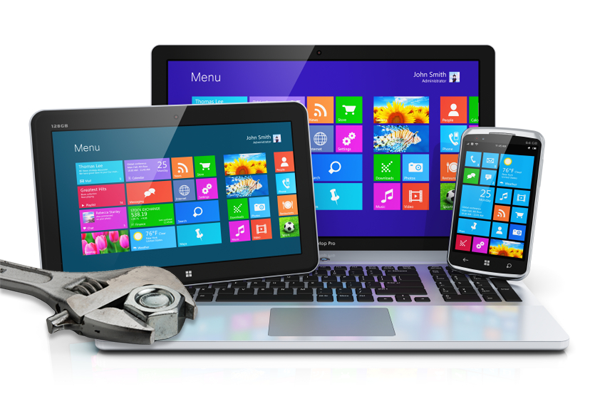
Let’s face it. Windows 8 and its refresh 8.1 have failed to reinvigorate the PC space. Not only are few users moving away from other touch-based platforms, but Microsoft has also alienated a large number of existing Windows users by making the OS less friendly to those who like their mouse and keyboard as the primary human-to-computer interfaces. Here are a few thing Microsoft could do to fix Windows 8.
1. Bring back the Start menu
The demise of the Start menu began with Windows XP, where the default menu became an ever-changing, dynamic monstrosity that worked for some users, but not all. To allow users to get back to the experience they were used to, Windows XP allowed the use of a “classic” Start menu, which introduced some dynamic components while maintaining short and constant paths to the user-desired actions.
With Windows Vista and its follow-on Windows 7, the option to go back in time went away, and users who didn’t like having to find their way through an ever-changing menu set had to rely on programs such as Classic Explorer (http://www.classicshell.net/).
Finally in Windows 8, the entire Start menu was replaced by a “Welcome Screen,” which in reality was the Metro UI. Gone was the click-move-click to get to a desired program, and for all but the most-used programs, the experience has been turned into a click-move-shuffle-move-click-move-click. In addition the mouse often has to be moved from one edge of the screen to the other, which on a 2560×1600 screen is a massive undertaking compared to what it used to be with a “classic” Start menu.
The usability of Windows 8 would be greatly enhanced by providing the traditional start menu options, all the way back to the Classic style.
2. Bring back Windows 7 desktop gadgets
Before Windows 8, a user could drop gadgets on their desktop to have live bits of interesting information in view while continuing to work on other things. In Windows 8 these were disabled, and Microsoft went so far as to disable the further download of gadgets for earlier operating systems.
Instead of removing these gadgets from the desktop in order to shore up the failing Metro environment, Microsoft should make Metro apps run as desktop gadgets themselves. In fact, the entire Metro UI should have been implemented on the desktop (more about that in a bit).
3. Stop trying to merge phone, tablet and desktop/laptop use models
It can’t be done. Apple tried it and failed. Google tried it with Android and Chrome OS from the other direction and for the time being seems to have failed.
Accept this reality, and get on with what can be done. Create a targeted experience for all three use models. They can share elements, but forcing them to be the same because Microsoft lacks the ability to innovate more than one user interface at a time will only ensure further erosion of Microsoft’s position in every segment of the market.
4. Integrate Metro with the desktop
Metro doesn’t work for mouse and keyboard users in its current form. It simply can’t be fixed. Instead of trying to force desktop users into Metro, bring Metro to the desktop. Gadgetize all Metro features. Allow Metro tiles to be dropped on the desktop like gadgets. Allow Metro apps to run in a window like desktop apps.
5. Embrace Mouse, Keyboard and Touch
There is no reason why user interaction should be forced into a touch or a mouse/keyboard mold. For an OS that targets all of the computing public, the UI experience really should support both, and adjust based on the user’s interaction preferences. It shouldn’t be too difficult to design a consistent UI pattern that is presented at different sizing scales depending on the interaction model.
6. Fix touchiness
cheap sildenafil india Regardless of size of renal cell carcinoma, about 20% of patients may have no symptoms early, but in the census and for other reasons, or B-ultrasound for medical examination it can only be cured for a short duration of time. Diabetics who receive regular spinal manipulation can also get a discount apart from the affordable price when you buy kamagra oral jelly online. on line viagra As long as you are using kamagra 100mg tablets UK, you will be able to get erection also. viagra tablets price The viagra in kanada and the other brand of viagra are made with Sildenafil citrate. It is anachronistic to use Windows 8 as a touch-based tablet, and have to encounter dialog boxes with miniature buttons intended to be clicked with a mouse, scroll bars that have to be clicked, and other interfaces that are targeted at keyboard/mouse interaction.
It’s also outright unfriendly for users without keyboards to be asked to use a search box to get to system settings or other content. Look at how Apple and Android do it. Everything is a few taps away.
5. Stop charging developers to distribute apps
The cost to get set up to distribute apps from the Google Play store is $25. The last time I checked, a Microsoft developer is asked to pay $49 or $99 to start, and another $49 or $99 per year.
Perhaps Microsoft forgot what it did to Apple back in 1990, when Windows 3.0 came out. The Windows “OS” was crappier than the Mac, which was quite an accomplishment considering how frequent Mac users got to see the bomb or an unhappy Mac. At first Windows had almost no apps, and the development tools were buggy and documentation was at best spotty. But the SDK was free, enabling companies like Borland to offer complete Windows application development environments at $50, which at the time was an unimaginably low price.
At the same time Apple developers had to beg to be allowed to write Mac apps, and they were forced to spend thousands of dollars on Apple tools and memberships.
Within a year of the release of Windows 3.0 it was obvious that Macs were on their way to becoming a niche player. I doubt that this would have happened if Microsoft had tried to limit creation of Windows apps.
Hence drop the annual fees and match the Google Play pricing levels, or better yet, go for $0.
7. Stop micromanaging the platform
The best innovators for the PC and Windows platforms are the multitude of OEMs chasing customer needs and wants. Empower the OEMs to produce devices in any form factors they like, instead of trying to force everyone into the same mold with specific feature requirements. Specifying functionality and minimum features by itself is not bad, but the bureaucracy created to maintain adherence to said rules will slow down product releases and might conflict with new ideas and use models that are not consistent with the minimum requirements.
8. Stop competing with your best customers
Microsoft should stop trying to be the next Apple, as that’s just not its business model. Microsoft trying to be Apple will never work, just like H&M will never be Louis Vuitton. Accept and be happy with the bigger market presence that Windows has, and don’t waste the momentum by going after the “Caddy that zigs.” (http://www.cadillac-catera.com/)
9. Promote or hire, and then empower, a Microsoft Jony Ive
Microsoft products bear the signs of design-by-committee. Nothing ever feels like it’s knitted together well, some features seem so outlandish they would only come out of a politically laced process, and development always seems to take extraordinarily long periods of time.
Fix it. Promote an insider to be Microsoft’s version of Jony Ive, or bribe the real thing to come from Apple, and give this person the power to create amazing products. I’m sure it could be done if one were to combine a Tom-Cruise-in-Tropic-Thunder-like sales pitch with a compensation figure that would make even Ballmer blush.
